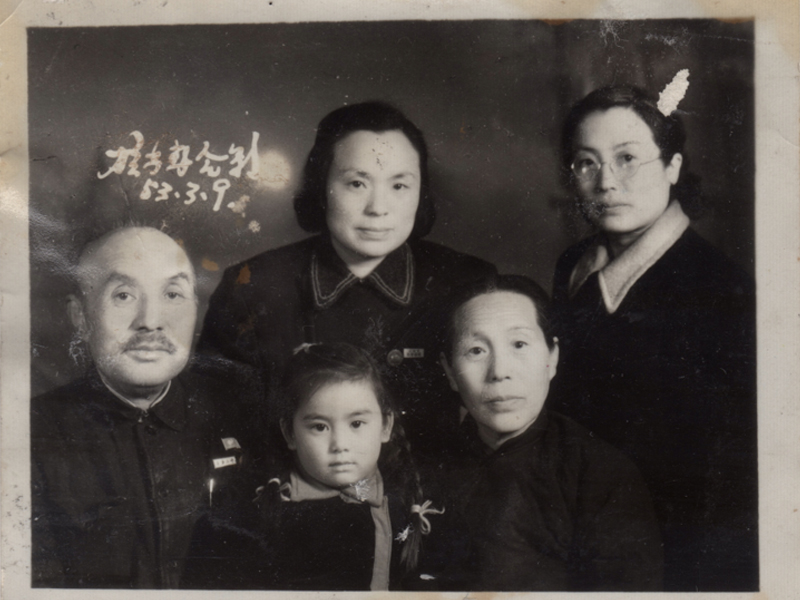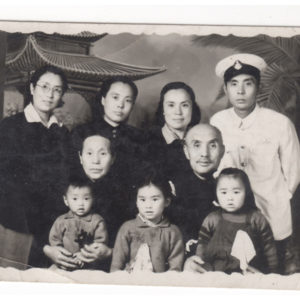For artist Hung Liu, engaging with portraiture is an act of empathy. Since the 1980s, she has paid tribute to hundreds of individuals by expanding upon photographic imagery to create complex, multilayered paintings. Growing up in Maoist China before immigrating to the United States, Liu has endured wars, forced labor, political revolutions, exile and displacement. Her story and her art present a complex, multifaceted picture of an Asian American experience, one represented by the Smithsonian National Portrait Gallery’s retrospective of Liu’s work, “Hung Liu: Portraits of Promised Lands.” The show marks the museum’s first solo exhibition of an Asian American woman, and more than 50 paintings, photographs and drawings examine Liu’s powerful art throughout the different chapters of her life. Perhaps no chapter of that life has been more foundational to Liu’s work than her childhood; Liu’s family photos and archives would go on to serve as perhaps the single greatest source of inspiration for her acclaimed artwork.
Family Ties
Raised primarily by her mother, a middle school teacher, Liu remembers her mother’s concerted efforts to document the family in annual trips to a photographer’s studio. This ritual began shortly after Hung Liu’s father was captured and imprisoned by Communist forces in September 1948. Just an infant at the time, Liu would not see her father again for more than 50 years. The childhood studio portraits became piercing reminders of his absence, yet they also signify the journey of a close, resilient and proud family.
In the late 1960s amid the Cultural Revolution, Hung Liu and her mother, Lu Zongguang, removed the photographs from their family albums to protect them from being taken by the Red Guards. Zongguang hid some of the pictures and set fire to the rest. She also burned her journals. Liu’s family, among countless others, felt compelled to erase their past so as not to leave a trace of their earlier, more privileged lives. Because Liu’s family was educated, they were seen as a threat to the government. Liu has carried these photographs with her through the years, not only as a reminder of her close-knit family, but also as a tribute to their bravery and sacrifice. Liu protects these photographs among her most cherished possessions and their images are embedded in her life’s work.
Portraits of the Past
The family photographs that Liu keeps with her have consistently served as the foundation for her approach to portraiture and Liu’s memories of her family are embedded in all of her portraits. She uses color, texture, found objects and shaped canvases to transport her family members into our contemporary moment and invites us to look upon them as though they were our own. The images predominantly feature women, and in nearly every one of these pictures, the individuals look determined and strong, traits that are often made visible through self-possessed expressions. The subjects’ faces act as templates, or maps, revealing the close intergenerational bloodlines of Liu’s upbringing. These are the faces that she draws on in her broader conceptualization of portraiture.
Portrait photographs and memories of their circumstances have the power of “summoning ghosts,” a phrase Liu often uses to describe her works. They offer stories of a family’s journey and help trace the impact of that journey on subsequent generations. Family photographs have traversed time and place with Liu, a reminder of the power that they hold in personal memory, allowing for threads of connection when physical contact has become impossible or has ended. Liu’s approach to portraiture is a humanistic, activist and ultimately hopeful means of making visible those who are at risk of being unseen and forgotten, those in her family and in all of our families.
“Hung Liu: Portraits of Promised Lands” will be on view at the National Portrait Gallery from Aug. 27, 2021 to May 30, 2022.
[Editor’s Note: Hung Liu passed away suddenly just before this article went to press.]
Related
Center Stage Academy for the Arts
The Visionary Arts Museum in Baltimore
Smithsonian Museum Programs for Young People with Disabilities



